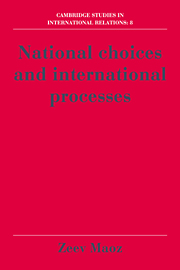Book contents
- Frontmatter
- Contents
- List of figures
- List of tables
- Preface
- 1 Toward a theory of international processes
- 2 Foreign policy decision making: assumptions and characterization of the approach
- 3 The inputs of decision making: identification and conceptualization
- 4 The essential mathematics of inputs
- 5 Models of the decision process
- 6 A formal characterization of decision processes
- 7 A theory of foreign policy decision making
- 8 The analysis of international outcomes
- 9 The evolution of international processes
- 10 Individual preferences, national choices, and international systems
- References
- Name Index
- Subject Index
5 - Models of the decision process
Published online by Cambridge University Press: 05 February 2012
- Frontmatter
- Contents
- List of figures
- List of tables
- Preface
- 1 Toward a theory of international processes
- 2 Foreign policy decision making: assumptions and characterization of the approach
- 3 The inputs of decision making: identification and conceptualization
- 4 The essential mathematics of inputs
- 5 Models of the decision process
- 6 A formal characterization of decision processes
- 7 A theory of foreign policy decision making
- 8 The analysis of international outcomes
- 9 The evolution of international processes
- 10 Individual preferences, national choices, and international systems
- References
- Name Index
- Subject Index
Summary
INTRODUCTION
This chapter reviews the second generation of foreign policy research. It discusses the strategies that individuals and groups employ when dealing with problems in terms of the decisional stages outlined in chapter 2. The discussion will be both integrative and critical. I will attempt to group together rather diverse theoretical and empirical studies into general models of foreign policy decision making, and connect levels of analysis in the process. This will enable assessment of the progress made during the second generation of foreign policy research.
The shift from research focusing on identification of inputs and the construction of input-output frameworks toward theories of decision making processes is attributable to a profound dissatisfaction with the nature and quality of the scholarly product of the former research orientation. The key assumption of the second stage of decision making research was that the proliferation of decisional inputs and the apparent failure to integrate these inputs was due to a failure to explore how various inputs affected the strategies of selecting and appraising alternatives by decision makers. If decision making processes are described rigorously, one could construct more valid hypotheses regarding the effects of various inputs on the process, thereby narrowing down the rather long laundry-list of exogenous factors. Alternatively, one can group together seemingly distinct inputs in a coherent fashion insofar as such inputs are presumed to affect stages of the decision process.
- Type
- Chapter
- Information
- National Choices and International Processes , pp. 149 - 223Publisher: Cambridge University PressPrint publication year: 1990

